 W
WEarth's climate arises from the interaction of five major climate system components: the atmosphere (air), the hydrosphere (water), the cryosphere, the lithosphere and the biosphere. Climate is the average weather, typically over a period of 30 years, and is determined by a combination of processes in the climate system, such as ocean currents and wind patterns. Circulation in the atmosphere and oceans is primarily driven by solar radiation and transports heat from the tropical regions to regions that receive less energy from the Sun. The water cycle also moves energy throughout the climate system. In addition, different chemical elements, necessary for life, are constantly recycled between the different components.
 W
WAir pollution is the presence of substances in the atmosphere that are harmful to the health of humans and other living beings, or cause damage to the climate or to materials. There are different types of air pollutants, such as gases, particulates, and biological molecules. Air pollution may cause diseases, allergies and even death to humans; it may also cause harm to other living organisms such as animals and food crops, and may damage the natural or built environment. Both human activity and natural processes can generate air pollution.
 W
WAlbedo is the measure of the diffuse reflection of solar radiation out of the total solar radiation and measured on a scale from 0, corresponding to a black body that absorbs all incident radiation, to 1, corresponding to a body that reflects all incident radiation.
 W
WThe carbonate–silicate geochemical cycle, also known as the inorganic carbon cycle, describes the long-term transformation of silicate rocks to carbonate rocks by weathering and sedimentation, and the transformation of carbonate rocks back into silicate rocks by metamorphism and volcanism. Carbon dioxide is removed from the atmosphere during burial of weathered minerals and returned to the atmosphere through volcanism. On million-year time scales, the carbonate-silicate cycle is a key factor in controlling Earth's climate because it regulates carbon dioxide levels and therefore global temperature.
 W
WCement clinker is a solid material produced in the manufacture of Portland cement as an intermediary product. Clinker occurs as lumps or nodules, usually 3 millimetres (0.12 in) to 25 millimetres (0.98 in) in diameter. It is produced by sintering limestone and aluminosilicate materials such as clay during the cement kiln stage.
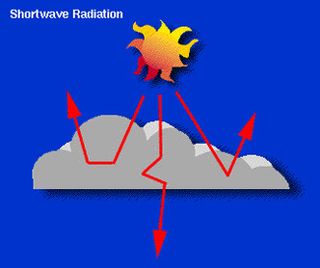 W
WIn meteorology, cloud forcing, cloud radiative forcing (CRF) or cloud radiative effect (CRE) is the difference between the radiation budget components for average cloud conditions and cloud-free conditions. Much of the interest in cloud forcing relates to its role as a feedback process in the present period of global warming.
 W
WContrails or vapour trails are line-shaped clouds produced by aircraft engine exhaust or changes in air pressure, typically at aircraft cruising altitudes several miles above the Earth's surface. Contrails are composed primarily of water, in the form of ice crystals. The combination of water vapor in aircraft engine exhaust and the low ambient temperatures that exist at high altitudes allows the formation of the trails. Impurities in the engine exhaust from the fuel, including sulfur compounds provide some of the particles that can serve as sites for water droplet growth in the exhaust and, if water droplets form, they might freeze to form ice particles that compose a contrail. Their formation can also be triggered by changes in air pressure in wingtip vortices or in the air over the entire wing surface. Contrails, and other clouds directly resulting from human activity, are collectively named homogenitus.
 W
WDeforestation is a primary contributor to climate change. Land use changes, especially in the form of deforestation, are the second largest anthropogenic source of atmospheric carbon dioxide emissions, after fossil fuel combustion. Greenhouse gases are emitted during combustion of forest biomass and decomposition of remaining plant material and soil carbon. Global models and national greenhouse gas inventories give similar results for deforestation emissions. As of 2019, deforestation is responsible for about 11% of global greenhouse gas emissions. Peatland degradation also emits GHG. Growing forests are a carbon sink with additional potential to mitigate the effects of climate change. Some of the effects of climate change, such as more wildfires, may increase deforestation. Deforestation comes in many forms: wildfire, agricultural clearcutting, livestock ranching, and logging for timber, among others. The vast majority of agricultural activity resulting in deforestation is subsidized by government tax revenue. Forests cover 31% of the land area on Earth and annually 75,700 square kilometers of the forest is lost. Mass deforestation continues to threaten tropical forests, their biodiversity and the ecosystem services they provide. The main area of concern of deforestation is in tropical rain forests since they are home to the majority of the planet's biodiversity.
 W
WEarth's energy budget accounts for the balance between the energy that Earth receives from the Sun, and the energy the Earth radiates back into outer space after having been distributed throughout the five components of Earth's climate system. This system is made up of Earth's water, ice, atmosphere, rocky crust, and all living things.
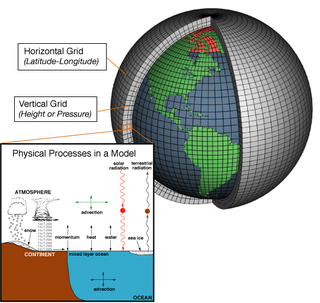 W
WA general circulation model (GCM) is a type of climate model. It employs a mathematical model of the general circulation of a planetary atmosphere or ocean. It uses the Navier–Stokes equations on a rotating sphere with thermodynamic terms for various energy sources. These equations are the basis for computer programs used to simulate the Earth's atmosphere or oceans. Atmospheric and oceanic GCMs are key components along with sea ice and land-surface components.
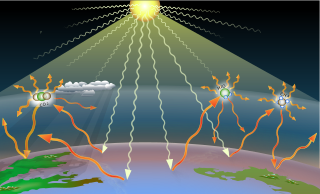 W
WThe greenhouse effect is the process by which radiation from a planet's atmosphere warms the planet's surface to a temperature above what it would be without this atmosphere.
 W
WA greenhouse gas (sometimes abbreviated GHG) is a gas that absorbs and emits radiant energy within the thermal infrared range. Greenhouse gases cause the greenhouse effect on planets. The primary greenhouse gases in Earth's atmosphere are water vapor (H2O), carbon dioxide (CO2), methane (CH4), nitrous oxide (N2O), and ozone (O3). Without greenhouse gases, the average temperature of Earth's surface would be about −18 °C (0 °F), rather than the present average of 15 °C (59 °F). The atmospheres of Venus, Mars and Titan also contain greenhouse gases.
 W
WHemispherical photography, also known as canopy photography, is a technique to estimate solar radiation and characterize plant canopy geometry using photographs taken looking upward through an extreme wide-angle lens or a fisheye lens. Typically, the viewing angle approaches or equals 180-degrees, such that all sky directions are simultaneously visible. The resulting photographs record the geometry of visible sky, or conversely the geometry of sky obstruction by plant canopies or other near-ground features. This geometry can be measured precisely and used to calculate solar radiation transmitted through plant canopies, as well as to estimate aspects of canopy structure such as leaf area index. Detailed treatments of field and analytical methodology have been provided by Paul Rich and Robert Pearcy (1989).
 W
WAn impact event is a collision between astronomical objects causing measurable effects. Impact events have physical consequences and have been found to regularly occur in planetary systems, though the most frequent involve asteroids, comets or meteoroids and have minimal effect. When large objects impact terrestrial planets such as the Earth, there can be significant physical and biospheric consequences, though atmospheres mitigate many surface impacts through atmospheric entry. Impact craters and structures are dominant landforms on many of the Solar System's solid objects and present the strongest empirical evidence for their frequency and scale.
 W
WA large igneous province (LIP) is an extremely large accumulation of igneous rocks, including intrusive and extrusive, arising when magma travels through the crust towards the surface. The formation of LIPs is variously attributed to mantle plumes or to processes associated with divergent plate tectonics. The formation of some of the LIPs the past 500 million years coincide in time with mass extinctions and rapid climatic changes, which has led to numerous hypotheses about the causal relationships. LIPs are fundamentally different from any other currently active volcanoes or volcanic systems.
 W
WMilankovitch cycles describe the collective effects of changes in the Earth's movements on its climate over thousands of years. The term is named for Serbian geophysicist and astronomer Milutin Milanković. In the 1920s, he hypothesized that variations in eccentricity, axial tilt, and precession resulted in cyclical variation in the solar radiation reaching the Earth, and that this orbital forcing strongly influenced the Earth's climatic patterns.
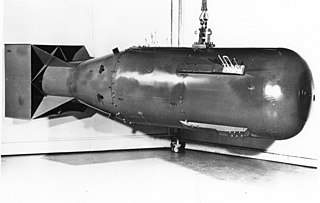 W
WNuclear winter is a severe and prolonged global climatic cooling effect hypothesized to occur after widespread firestorms following a nuclear war. The hypothesis is based on the fact that such fires can inject soot into the stratosphere, where it can block some direct sunlight from reaching the surface of the Earth. It is speculated that the resulting cooling would lead to widespread crop failure and famine. When developing computer models of nuclear-winter scenarios, researchers use the conventional bombing of Hamburg, and the Hiroshima firestorm in World War II as example cases where soot might have been injected into the stratosphere, alongside modern observations of natural, large-area wildfire-firestorms.
 W
WParticulates – also known as atmospheric aerosol particles, atmospheric particulate matter, particulate matter (PM), or suspended particulate matter (SPM) – are microscopic particles of solid or liquid matter suspended in the air. The term aerosol commonly refers to the particulate/air mixture, as opposed to the particulate matter alone. Sources of particulate matter can be natural or anthropogenic. They have impacts on climate and precipitation that adversely affect human health, in ways additional to direct inhalation.
 W
WRadiative forcing is the difference between solar irradiance (sunlight) absorbed by the Earth and energy radiated back to space. Changes to Earth's radiative equilibrium that cause temperatures to rise or fall over decadal periods are called climate forcings. Positive radiative forcing means Earth receives more incoming energy from sunlight than it radiates to space. This net gain of energy will cause warming. Conversely, negative radiative forcing means that Earth loses more energy to space than it receives from the sun, which produces cooling. A system in thermal equilibrium has zero radiative forcing.
 W
WShip tracks are clouds that form around the exhaust released by ships into the still ocean air. Water molecules collect around the tiny particles (aerosols) from exhaust to form a cloud seed. More and more water accumulates on the seed until a visible cloud is formed. In the case of ship tracks, the cloud seeds are stretched over a long narrow path where the wind has blown the ship's exhaust, so the resulting clouds resemble long strings over the ocean. Ship tracks are a type of homogenitus cloud.
 W
WPatterns of solar irradiance and solar variation has been a main driver of climate change over the millennia to gigayears of the geologic time scale, but its role in the recent warming has been found to be insignificant.
 W
WStratospheric sulfur aerosols are sulfur-rich particles which exist in the stratosphere region of the Earth's atmosphere. The layer of the atmosphere in which they exist is known as the Junge layer, or simply the stratospheric aerosol layer. These particles consist of a mixture of sulfuric acid and water. They are created naturally, such as by photochemical decomposition of sulfur-containing gases, e.g. carbonyl sulfide. When present in high levels, e.g. after a strong volcanic eruption such as Mount Pinatubo, they produce a cooling effect, by reflecting sunlight, and by modifying clouds as they fall out of the stratosphere. This cooling may persist for a few years before the particles fall out.
 W
WSunlight is a portion of the electromagnetic radiation given off by the Sun, in particular infrared, visible, and ultraviolet light. On Earth, sunlight is scattered and filtered through Earth's atmosphere, and is obvious as daylight when the Sun is above the horizon. When direct solar radiation is not blocked by clouds, it is experienced as sunshine, a combination of bright light and radiant heat. When blocked by clouds or reflected off other objects, sunlight is diffused. Sources indicate an "Average over the entire earth" of "164 Watts per square meter over a 24 hour day".
 W
WThe Twomey effect describes how additional cloud condensation nuclei (CCN), possibly from anthropogenic pollution, may increase the amount of solar radiation reflected by clouds. This is an indirect effect by such particles, as distinguished from direct effects (forcing) due to enhanced scattering or absorbing radiation by such particles not in clouds. Cloud droplets normally form on aerosol particles that serve as CCN. Increasing the number concentration of CCN can lead to formation of more cloud droplets, which, in turn, have smaller size.
 W
WAn urban heat island (UHI) is an urban area or metropolitan area that is significantly warmer than its surrounding rural areas due to human activities. The temperature difference is usually larger at night than during the day, and is most apparent when winds are weak. UHI is most noticeable during the summer and winter. The main cause of the urban heat island effect is from the modification of land surfaces. Waste heat generated by energy usage is a secondary contributor. As a population center grows, it tends to expand its area and increase its average temperature. The term heat island is also used; the term can be used to refer to any area that is relatively hotter than the surrounding, but generally refers to human-disturbed areas.
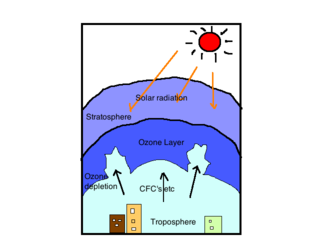 W
WVery short-lived substances (VSLS) are ozone-depleting halogen-containing substances found in the stratosphere. These substances have very short lifetimes, typically less than 6 months. VSLS are responsible for atmospheric damage once they enter the stratosphere and are a contributing factor to the destruction of ozone.
 W
WWaste heat is heat that is produced by a machine, or other process that uses energy, as a byproduct of doing work. All such processes give off some waste heat as a fundamental result of the laws of thermodynamics. Waste heat has lower utility than the original energy source. Sources of waste heat include all manner of human activities, natural systems, and all organisms, for example, incandescent light bulbs get hot, a refrigerator warms the room air, a building gets hot during peak hours, an internal combustion engine generates high-temperature exhaust gases, and electronic components get warm when in operation.
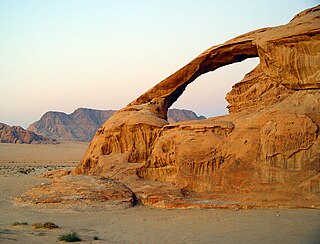 W
WWeathering is the breaking down of rocks, soils, and minerals as well as wood and artificial materials through contact with the Earth's atmosphere, water, and biological organisms. Weathering occurs in situ, that is, in the same place, with little or no movement, and thus should not be confused with erosion, which involves the transport of rocks and minerals by agents such as water, ice, snow, wind, waves and gravity and then being transported and deposited in other locations.
 W
WWildland fire and wildland fire atmospheric emissions have been a part of the global biosphere for millennia. The major wildland fire emissions include greenhouse gasses and several criteria pollutants that impact human health and welfare.: